Fact Sheet FS1330
Background
Pepper weevil is a destructive pest that is brought into New Jersey from areas where it is endemic. It is not a migratory pest but is transported in pepper fruit harvested from infested fields. Current pepper production and shipping practices provide the means for pepper weevils to infest locations distant from the originally infested field.
In New Jersey and elsewhere, it has been determined that food processing plants that import infested pepper produce are the primary means of spreading the weevil. When processing waste is deposited into a dumpster, the adult weevils disperse into the surrounding area where they may infest nearby fields directly or may be transported on vehicles and produce bins to farms.
It is critical that farmers detect the initial presence of the weevils in the field. Once found, farmers should apply an insecticide as soon as possible. Once a population has become established in the field, they cannot be eradicated with currently registered insecticides. Losses to the weevil range from negligible to total loss.
Biology and Damage
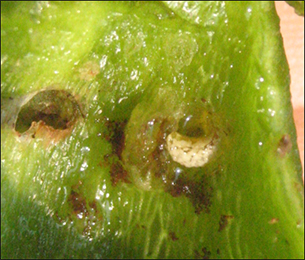
Figure 2. A mature grub in the center of the pith.
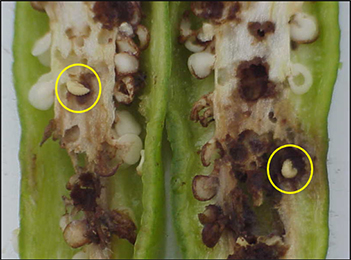
Figure 1. A pupa (left) and a grub (right) and damage inside of a chili pepper.
The weevil can complete a generation in 2 ½ to 3 ½ weeks. The female lays 200 to 300 eggs, singly, into flowers or developing fruit. When the eggs hatch, the grubs begin feeding on the interior of the pepper in the pith and mesocarp (Figs. 1, 2). The plant discerns the infested fruit and aborts it. The weevil grub continues its development to the pupal and adult stages inside the fallen fruit. When the smaller fruit have been aborted, the weevil begins laying eggs in larger fruit which will not be aborted.
While pepper weevils cannot overwinter in New Jersey, they may appear in early spring because processing facilities are bringing in southern produce and the weevils are escaping. Fields transplanted in late April or early May can become infested almost immediately.
Because of its short generation time, multiple generations of weevils may occur in a growing season in New Jersey. Assuming 50% mortality of its progeny, one female weevil can produce a population of about 1,000,000 weevils in 9 weeks. When weevils enter pepper fields after transplanting, total losses are possible usually occurring by mid-July to early August. Most weevil infestations are detected in August. Though not documented, there may be multiple introductions of weevils into a field.
Loss of yield can be estimated by calculating the number of row feet per acre. Divide the row feet by ten then multiply by the number of fruits aborted in a 10-foot section of row. This will give the gross loss.
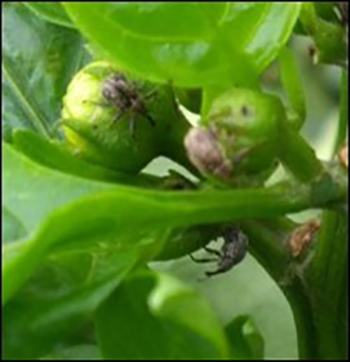
Figure 3. Three adult weevils moving about flower buds.
Field Scouting
Adults can be found in the upper portions of the plant around flowers and developing fruit (Fig. 3). However due to their small size and readiness to fly, detecting them is difficult. Looking for infested fruit both on the plant and on the ground may be more effective in determining whether weevils are present in the field. Before being aborted, the stem of the infested fruit will turn yellow and begin to shrivel. Small fruit found on the bed or ground can be cut open to see whether grubs or pupae are present inside (Fig. 2). The threshold that we use in New Jersey is one weevil, whether live adult on the plant or the immature stages in aborted fruit. If pheromone traps are used, the threshold is again, one weevil.
Monitoring
The standard trap for pepper weevil consists of a yellow sticky card with two pheromones for attractants, a mating pheromone and an aggregation pheromone. Pepper weevils are attracted to the yellow cards without lures but are much less likely to catch weevils than those cards with lures. The lured, yellow cards can be supported on a ¼ inch dowel. The card should be positioned so that it is at or above the level of the plant canopy. Kits for the traps can be purchased at:
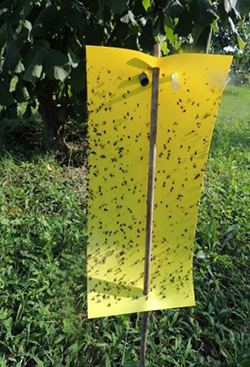
Figure 4. A pepper weevil trap in field with lures.
There may be different methods to set the lured, yellow sticky card in the field, but the way that has been done in the Rutgers NJAES Vegetable IPM Program is as follows:
Deployment of Traps

Figure 5. A newly trapped pepper weevil.
The location of the field is important. Is the field near a processing plant or a landfill (2 miles or closer to either) or near other pepper fields or solanaceous crops? Weevils will feed on tomatoes, eggplant, and possibly potatoes, and solanaceous weeds, such as nightshade. These other crops and weeds are acting like stepping stones to provide access to pepper fields where the weevils can reproduce. Placement of pepper fields and solanaceous crops may have to be coordinated with neighboring farms to help prevent the natural spreading of the weevils.
Given the amount of maintenance required to keep the traps operational, a few traps should be placed at strategic points along the perimeter of the fields instead of being placed all around the perimeter. For fields that are isolated, determine the access points for the field. Where is the most traffic? Traps should be placed near where the movement of machinery and produce bins will be coming in and out of the fields. Likewise, one or more traps should be placed in and around the packing shed where the most farm traffic will be. At least one trap should be placed along a border with a highway. Pheromone traps are the most effective and useful early in the season.
Identifying Trapped Weevils
This can be difficult as some non-pest weevil species attracted to the pheromone traps are superficially similar to pepper weevils. The most diagnostic characters to look for are (refer to Fig. 5):
- the long slender beak which makes up about ⅓ the length of the weevil,
- the widest part of the body is towards the rear of the insect,
- their color ranges from black to light brown with white flecks and often a small white spot at the base of the wing covers,
- the most important character is the short spur or spine on the underside of each of leg towards the end of the largest leg segment (Fig. 6, 7).
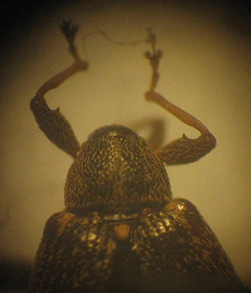
Figure 7. The arrows point to the spurs on the underside of the forelegs. Spurs like these occur on all legs.
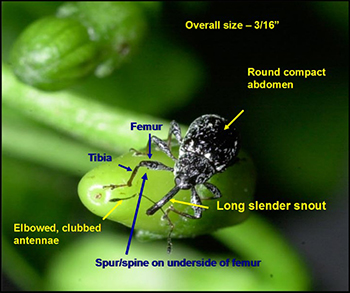
Figure 6. To identify pepper weevil, look for the long beak, wide hind body, dark to light color with white flecks or spot near the base of the wing covers, and the spurs on the underside of all legs.
Management
Management of pepper weevil is difficult. Adult weevils are small and can easily hide in foliage. They are not strong fliers but fly readily when disturbed. Weevils have a penchant for hitchhiking on vehicles and are easily transported to new locations. To help manage weevils more effectively, farmers should think of a weevil infestation like a plant disease requiring multiple pesticide applications. Farmers cannot spray once or twice to eliminate a weevil infestation as they might be able to do with other insect pests. That said, timely spraying after the initial detection has prevented infestations for some farms in southern New Jersey. Besides spraying an insecticide, there are other options for reducing the risk of having pepper weevils.
Avoidance, including location of field sites may be the most effective management tool.
- If possible, do not plant peppers within two miles of a processing plant or landfill. This helps prevent infestations resulting from the natural spread of weevils from these sites. Also, because prevailing winds and storms may help in moving weevils about, try to plant peppers on the upwind side of processing plants and landfills.
- If possible, work with surrounding farms to prevent close or adjacent plantings of peppers or other solanaceous crops. Even though weevils do not reproduce in tomatoes and are unlikely to in eggplant, the weevils will feed on these crops and use them as stepping stones to reach more distant pepper fields illustrated in Fig. 8.
- Do not apply raw vegetable waste to fallow fields. Adult weevils escaping from raw pepper waste in the field or from dumpsters is the major source of infestations in New Jersey fields. On-farm cull piles are strongly discouraged.
- Power wash produce bins and vehicles coming from a processing plant before arriving at a farm. Just as with plant diseases, sanitation is important. Use a carwash, if available.
- Apply an insecticide at first bloom/fruit set after transplanting to prevent the early establishment of a weevil population. This is particularly important for fields in high-risk areas near processing plants and landfills.
- Apply an insecticide immediately upon the detection of even one weevil. In some cases, this has prevented the establishment of a weevil population.
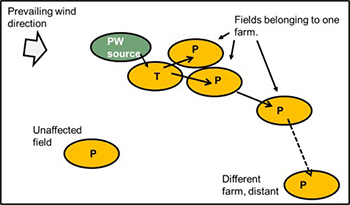
Figure 8. A diagram showing the importance of wind direction and location of fields relative to the weevil source and each other. PW – pepper weevil; T – tomato; P - pepper.
Another aspect of avoidance is reducing the infield traffic throughout the field season. The more off-farm traffic from agribusiness/extension/social services or anyone else visiting infested and non-infested farms, the greater the likelihood of spreading weevils farm to farm. Farmers should inform anyone coming to the fields if the fields are infested.
Once a farm’s peppers are infested, the two primary management tools are insecticide applications and removal of aborted fruit. Both options are important, but the removal of aborted fruit is much more labor intensive. The removal and destruction of aborted fruit breaks the life cycle of the weevils and reduces the number of reproducing adults. This tactic is especially important in greenhouse production where aborted fruit could be more easily removed.
Insecticide Recommendations
Insecticides used to manage established weevil populations will likely only suppress the weevils. Currently, there are no registered insecticides that will eradicate weevils so that multiple insecticide applications will be necessary for as long as a farmer intends on harvesting the peppers.
Bioassays conducted by University of Georgia at Athens confirmed that all populations of weevils tested from Georgia are resistant to pyrethroid insecticides. This presents problems for New Jersey farmers since there is no timely means to determine where infesting weevils are originating from and whether they are resistant. Alternate chemistries probably should be used instead of pyrethroids used solely for weevil control.
Recommendations from Florida as of this writing are to rotate insecticide applications. For example, use a neonicotinoid followed by oxamyl, followed by tolfenpyrad or a diamide, such as cyclaniliprole. Among the neonicotinoids, thiamethoxam seems to provide the best results, but some farmers prefer to use imidacloprid because it is less expensive. Growers should refer to the appropriate production guides for current insecticide recommendations.
Summary
Pepper weevil can be a primary pest of peppers wherever peppers are grown. The weevils are easily spread by several means including the normal shipment of foodstuffs. The adoption of precautionary measures, including monitoring for the presence of the weevil, is currently the best way to avoid weevil infestations in pepper crops. While insecticide applications can suppress weevil populations, no insecticides currently available can eradicate a weevil population, once established.
Mention or display of a trademark, proprietary product, or firm in text or figures does not constitute an endorsement by Rutgers Cooperative Extension and does not imply approval to the exclusion of other suitable products or firms.
May 2021
Copyright © 2024 Rutgers, The State University of New Jersey. All rights reserved.
For more information: njaes.rutgers.edu.
Cooperating Agencies: Rutgers, The State University of New Jersey, U.S. Department of Agriculture, and Boards of County Commissioners. Rutgers Cooperative Extension, a unit of the Rutgers New Jersey Agricultural Experiment Station, is an equal opportunity program provider and employer.

